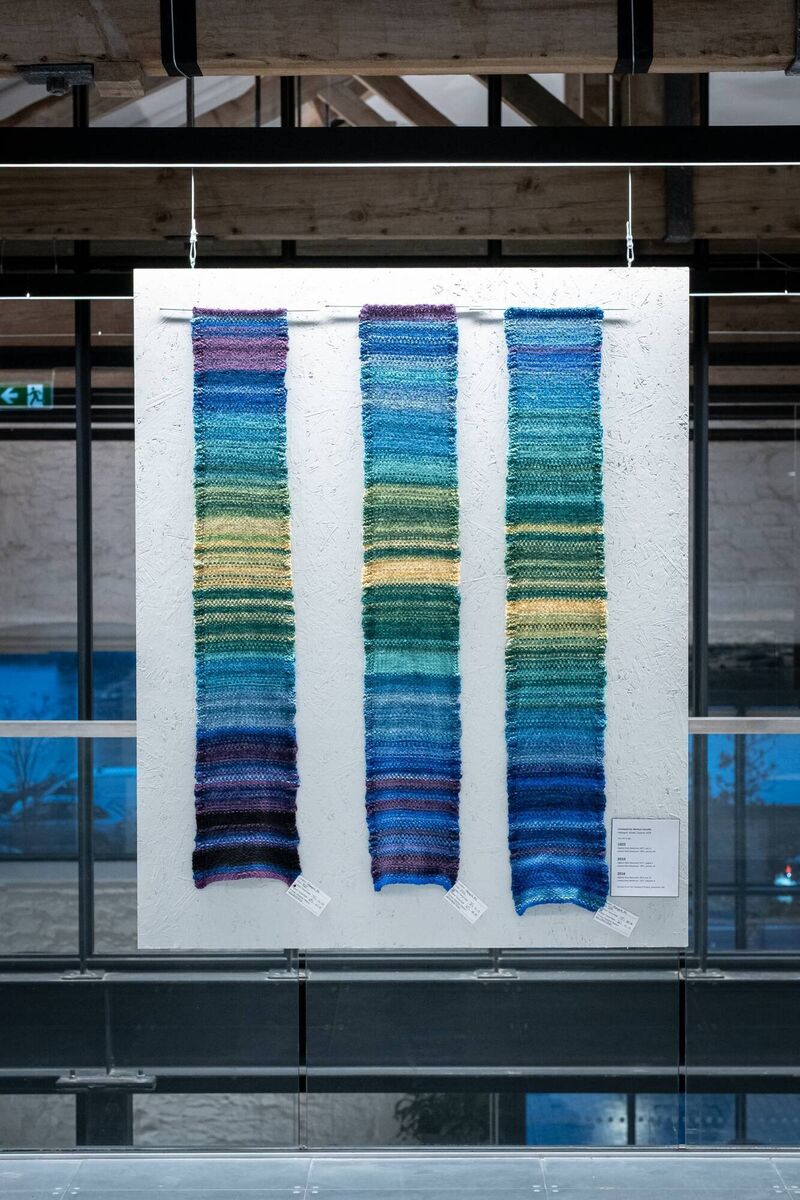Jools Gilson of UCC: Mapping Climate Change at Cork's newest art venue

Jools Gilson is curator of Mapping Climate Change: The Knitting Map and The Tempestry Project, currently in Cork.
It’s always a delight when new exhibition spaces for art pop up around Cork city. The latest is at 1 Horgan's Quay, near Kent railway station, where Mapping Climate Change: The Knitting Map and The Tempestry Project will run until December 6. The exhibition, curated by Jools Gilson, Professor of Creative Practice at UCC, is the very first at the venue.
“The space is extraordinary,” says Gilson. “It’s the mezzanine of what used to be a CIE warehouse. It was where materials were stored when they were being brought up and down to Cork by train. It’s really open to the city, right in the heart of it, and it overlooks the River Lee, so you can see the rowers going by, and the boats. And then there are the skylights above us; we’ve had rain one moment, and sunshine the next.”
The space has not been without its difficulties in terms of installing the show. “It’s a listed building, so they’ve had to preserve the structure. That means we couldn’t hang work on the walls, we’ve had to hang it from the rafters instead. They’re five metres up, so it’s been challenging.”
The Knitting Map was co-ordinated by Gilson and Richard Povall, her partner in the arts production company Half/angel, as part of Cork 2005, the year-long programme of events organised to mark the city’s tenure as European Capital of Culture. It was knitted by a team of more that 2,500 volunteers at St Luke’s Church, working to a design based on weather data collected around Cork city.

The Map has since been exhibited in the US on several occasions. It was first paired with the Tempestry Project for a series of Mapping Climate Change exhibitions at the Berman Museu at Ursinus College in Pennsylvania in 2021 before touring to the Kohlet Gallery at Lawrence University in Winconsin and the Art Museum at West Virginia University in Morgantown in 2024.
“I’m really pleased to have the Knitting Map back in Cork for the 20th anniversary of its creation,” says Gilson, “particularly as it is being shown with this later project it helped inspire.”
Tempestry is a play on the words ‘temperature’ and ‘tapestry’, and was chosen by Emily McNeil, Marissa Connelly and Justin Connelly to describe the project they founded in Anacortes, Washington in 2017. Using climate research data from the Naval Air Station on Whidbey Island, Washington, they produced a series of knitted artworks – or Tempestries - whose rows each represent the temperature on a given day over a period of years.
The Tempestries are strikingly colourful. “For the Knitting Map, we chose a kind of muted palette on purpose, because that's what we thought was beautiful,” says Gilson. “But also we wanted to avoid bright colours. Whereas with the Tempestry Project, we have the typical connection of bright and dark reds for heat, and bright and dark blues for cold.”
Some of the Tempestries chronicles the temperatures in Utqiagvik, the most northern city in Alaska. “It’s one of the coldest places in the US. The rows of knitting reflect the temperatures from 1925 to 2010. You can see by the colours how much colder it was in 1925 than it is today.”
More chronicle the temperatures in Death Valley, California. “Some are from 1950, and others from 2016, so there’s a time difference of 56 years. But again, you can see how the climate is obviously warming.”
There is also a pair of New Normal Tempestries, which demonstrate how specific events have impacted on the climate. “One is for the US landmass, the other is for the world. They’re got little tags that read, ‘End of World I,’ ‘Krakatoa erupts,’ and so on.”
It is no coincidence that the Knitting Map and the Tempestries Project both combine climate activism with traditional craft skills. “These are methodologies that are usually associated with the private sphere and the home,” says Gilson. “I suppose what's important is not just the documentation of climate data and how the world is warming, but also about how we’re using artistic methodologies, and particularly textiles, to assert a kind of radical hope around community and connection and touch, to assert that small things matter, because it can easily feel like they don't.”
Over the past eight years, the Tempestry Project organisers have made kits available to groups around the world. To date, Tempestries have been created in every single state across the US, and in more than 20 other countries.
As part of the Mapping Climate Change exhibition, Gilson will oversee the creation of a new set of Tempestries by volunteers in Cork. “One will be based on the climate information for Cork in 2024, the last full year we have the records for. Another will be based on the records for Cork in 1974. We had intended using the records for Cork in 1924 as well, but the thing with weather data in Ireland is, it isn’t always straightforward, and we couldn’t find the data for that year.
“But I know a few climate scientists at UCC, and they found me the unpublished data from Roches Point. It's actually really nice, given that UCC has provided a lot of the funding for this exhibition, that they've contributed this information as well.”
The new Tempestries will be created at 1 Horgan Quay. “I'm hoping that at least some of the knitters from the Knitting Map from 20 years ago will be involved,” says Gilson. “All going well, we’ll be able to display the Cork Tempestries by the end of the exhibition.”
- Mapping Climate Change: Knitting Map and The Tempestry Project runs at 1 Horgan Quay, Cork, until December 6. Further information: ucc.ie/events

Featuring work by Cormac Boydell, Sinéad Fagan, Ita Freeney, Mags Geaney, Michael Quane and many others.
Presented in collaboration with the Hayward Gallery in London, featuring work by Daphne Wright, Paula Rego, Celia Paul, Tracey Emin and many others.
The first exhibition in Ireland by the renowned Chilean artist, poet and activist, exploring themes of ancestry, ecological urgency and the interconnectedness of humanity.
An exhibition of paintings, prints and sculpture by the Cork-born artist, a Master’s in Painting graduate of the Royal College of Art in London.
An exhibition of 250 fossil specimens, along with artworks by Tom Climent, Johanna Connor, Damien Flood, Angela Gilmour and Emma O’Hara.




